Elevated mercury concentrations in the surface environment continues to attract increasing research attention worldwide. Like many heavy metals, anthropogenic mercury in the environment today may have a complicated and often unknown story of how it got there to begin with. An understanding of how and when mercury is released into the environment, whether anthropogenic or ‘natural’ the mercury input is, and whether mercury inputs are local or distant, is needed in order to build a complete understanding of how human activities have modified the mercury cycle.
In Australia, the history of mercury pollution has become an area of exciting area of comparatively recent research, with researchers connecting the environmental history of early (Colonial-era) mining to the earliest anthropogenic release of mercury into the environment here. In the case of the lower Hunter Valley of NSW, elevated mercury in recent sediments collected from floodplain lakes is clearly associated with a local mercury source, coal-fired power stations (Schneider et al., 2021). However, the application of isotopic ‘fingerprinting’ of the source of the mercury, and then matching this to the isotopic signature preserved in the local sediment sinks, is a powerful means of confirming the dominance of local anthropogenic sources, but also (importantly) provides a history of mercury pollution from coal-fired power generation in the region (Schneider et al., 2021).
With the widespread dispersal of mercury in aerosols and dust atmospherically, there are instances when anthropogenic mercury deposited in one location can have an entirely different (and often longer) history of release. We see this in records of mercury deposition from remote locations in the Southern Hemisphere, for example, where increases in mercury atmospheric deposition show that anthropogenic mercury can travel long distances (hemispherically, and globally) and that distance ‘pristine’ environments are not spared from the consequences of global industrial activity. Given Australia’s remote location compare with the Americas and Europe (in particular), we may consider the history of anthropogenic mercury to be relatively short and straightforward here, however the chronologies and potential sources of anthropogenic mercury increase in complexity once we examine sites further afield.
In my current study area, eastern Mexico and Central America (Mesoamerica), the indigenous peoples of the region have been using mercury for thousands of years, but exactly how, why, where and when, remains poorly understood. Some of the earliest evidence of purposeful use of mercury by early Mesoamerican peoples is mercuric-sulphide (HgS) paint on sculptures by the Olmec (a cultural group we still know little about) from the area we today call Campeche (Mexico), dating to the 12th century BCE or earlier (MetMuseum). The archaeological record of mercury across the Mesoamerican region has offered tantalising glimpses of prehispanic peoples, especially the Maya, using mercury for ritual and craft production purposes across many sites. Yet, without written records or other lines of evidence, we cannot say if the Maya’s use of mercury was limited to these areas of society alone.
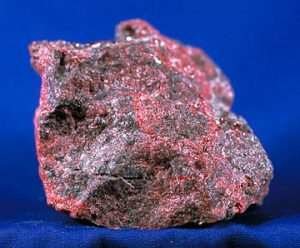
At many Maya sites across Mexico, Guatemala and Belize, archaeologists have come across the tell-tale bright red-coloured powder of cinnabar ore (HgS), often scattered across ritual spaces and contexts, including tombs and temples. The theory goes that the bright red colour of powdered cinnabar, when mixed with water, reminded the Maya of blood, and important element of their cultural and religious practices. We have probably all heard of the different blood-letting and human sacrifice elements of ancient Maya society –– or at least seen an Indiana Jones movie –– so no further details will be provided here. Exceptional examples of the use of mercury by the Maya include the so-called ‘Red Queen’ of Palenque, who is named after the tomb and burial decorations she enjoyed that were entirely covered in cinnabar powder (Manrique-Ortega et al., 2020).
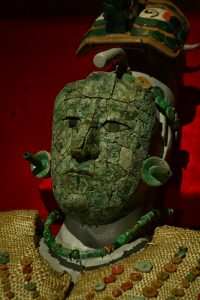
In a very few number of Maya settlements, deposits of native mercury (mercury in its ‘pure’ liquid form) have been uncovered in contexts that date to the Late Classic Period (7-10th century AD) (Pendergast, 1982). This hints at the Maya having some means of smelting native mercury from the cinnabar ore sources they were accessing, but to date, no archaeological evidence of smelting technology has been unearthed. Furthermore, the prehispanic Maya did not have or use metal, which at least in Old World societies, was a requirement for having the means to smelt liquid mercury from ore (Brooks, 2012). The unresolved question of how and where the Maya obtained liquid mercury is not only important for our understanding of the early industrial archaeology of the Americas, but one that could provide insights into the scale and timing of early smelting and related atmospheric mercury pollution from the region.
Since the 1970s, geoscientists working on Maya archaeological research projects have investigated the anthropogenic chemistry of sediment and soils from Maya settlements as evidence of past human activity (Cook et al., in press). Studies of environmental mercury at Maya sites has taken place since the 2000s along with the increasing availability of laboratories and equipment capable of low-level mercury detection. We now know that the past use of mercury by the ancient Maya was of such scale that it left behind elevated mercury levels in the environment that we can measure today. High levels of mercury (often c. 1 ppm, but up to 20 ppm) have been measured in buried soils, archaeological strata and sedimentary records at Maya sites in Mexico, Guatemala and Honduras (Cook et al., in press). The mercury is almost certainly anthropogenic, as pre-Maya soils and sediments contain negligible mercury and, in some studies, elevated mercury in Maya palaeosols has been directly linked to co-located artefactual cinnabar materials (Cook et al., 2006). And while there are very few geological sources of cinnabar in the region (and soils and sediments are natural extremely low in mercury), we do not yet know the impact of late Holocene volcanic activity in the region and how atmospheric mercury from large eruptions in southern Guatemala and further south (Dull et al., 2019) may have contributed to mercury increases in the landscape thousands of years ago (Tankersley et al., 2011).
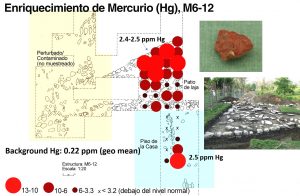
The chronology of anthropogenic mercury contamination at Maya sites sits around the Late Classic period though this may be an artefact of the occupation periods of the Maya sites examined for mercury so far, and further work on the chronology of anthropogenic mercury accumulation in the landscape is needed before anything more concrete around chronology could be said. A great advance in our understanding of how long anthropogenic mercury may have been released into the environment by the Maya comes from recent work of Prof David Lentz and colleagues at the University of Cincinnati (USA), from one of the most important Maya cities, Tikal in Guatemala.
Tikal is located in the cradle of the Maya civilisation, in the Petén region of northern Guatemala, an area home to hundreds of ancient settlements (many still unexcavated) linked by road networks in a tropical metropolis. Tikal is distinguished from some other large Maya settlements by its high density of urbanisation and by the height of pyramids constructed here, which some have likened to skyscrapers of the ancient world. High populations at Tikal were sustained for centuries, in part, by a sophisticated water management system that included water purification systems and numerous artificial reservoirs located near the centre of the city.
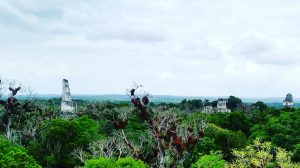
By studying well-dated deposits of anthropogenic sediments that accumulated in the artificial reservoirs during (and after) the Maya period, Prof Lentz and colleagues have successfully reconstructed the history of environmental change at Tikal in response to growing human population and land use over 3000 years (Lentz et al. 2020). A focus of their research was to explore what evidence of past water quality might be preserved in the reservoir sediment sequences. Along with other proxies of water quality, Lentz et al. (2020) examined the inorganic geochemistry of the sediment sequence, including testing for mercury levels. Like many ancient Maya settlements, Tikal is situated within a karst limestone environment, and soils and sediments naturally have very low levels of mercury. Even so, the research team were not entirely surprised to find that the reservoir sediments contain some mercury, based on past Maya mercury studies in the region, but the temporal trends and magnitude of mercury preserved in the sediments were such that they had the mercury sequence reanalysed at an external laboratory to confirm their earlier findings. The first wave of mercury analysis was completed using mass-spectrometry methods at the University of Cincinnati, while the re-analysed work was undertaken by the US EPA, who determined the total concentration of mercury by AAS using a Milestone DMA-80, with 3 repeats per sample.
The results from Tikal have pushed back the start date for anthropogenic mercury use (and pollution) in the Maya world into the Preclassic period and the first millennia BCE, up to 1000 years earlier than previously thought, based on palaeosol studies from Late Classic Maya sites in the region. Even so, the reservoir sediments that consistently recorded high (> 1ppm) levels of mercury were from the later part of Tikal’s history, the Late Classic and Terminal Classic periods, which fits well with the mercury chronology from other Maya sites. The much earlier dates for mercury use by the ancient Maya is significant for our understanding of the long human use of mercury. In the pre-Columbian Americas, the mercury history from Tikal overlaps that of the Olmec culture from Mexico, based on dates of Olmec settlements where figurines with cinnabar-based paint have been located. While cinnabar use by ancient societies in Asia and Europe extends back into the early Holocene, the famous writings describing substantial mercury from ancient Greece and Rome (for example), start from the 1st century BC (e.g., Vitruvius and Pliny the Elder). The revised history of mercury use in the ‘New World’, from the realm of the ancient Maya, seems to now overlap with the well-documented growth of mercury use in southern Europe in the late first millennium BCE.
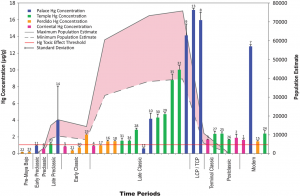
The research on environmental mercury accumulation in prehispanic Maya landscapes has been sharply focused on locally-derived anthropogenic mercury use as the source of contamination. But as many studies suggest, at greater spatial scales, atmospheric mercury deposition can be the major source of mercury flux to the terrestrial environment. Historic mining of mercury in northern Mexico (and possibly southern Guatemala and further south again) may have been a source of not just localised mercury contamination, but a substantial source of airborne mercury. Unfortunately, there has been no research to date from the region which can provide data on atmospheric regional sources of mercury deposition.
Back here in Australia, we have an increasing number of projects that are reconstructing histories of anthropogenic mercury use, showing the dominance of local-scale human activities in releasing mercury into the environment that is then preserved for long periods of time (permanently?). The importance of local-scale mining and other industrial activities in driving mercury pollution in Australian studies is clear, while mercury deposition from further afield appears to play a much smaller role in total environmental mercury inventories. However, in distant locations where no dominant local sources of mercury pollution exist, is it possible that long-distance transport of historic mercury from much earlier (mid-late Holocene) human activities may have resulted in levels of mercury deposition above background levels? Researchers have proposed that this is the case in some very remote locations Southern Hemisphere, where no local sources of anthropogenic mercury pollution are found, such as the peat bogs of Patagonia, Chile. Here, preindustrial levels (c. 2000 years BP) of anthropogenic mercury are similar to those recorded in European peat bogs, thought to be from changes in atmospheric mercury concentrations on a global scale, rather than any local preindustrial mercury inputs (Biester et al., 2002). Even further away from global hotspots of preindustrial mercury use is West Antarctica (about 63.5°S), where mercury levels in seal hairs preserved in an ice-core provided a long (2000-year) record of anthropogenic mercury emissions arriving in Antarctica from very far afield, purportedly from ancient mercury use and atmospheric emission from the Northern Hemisphere (Sun et al., 2006).
Establishing the source of mercury in environmental archives (i.e., tree rings, sedimentary sequences, palaeosols) is important if we are to distinguish between local and far-afield mercury sources, and the recent work of Schneider et al. (2021), for example, is a valuable illustration of how this can be applied in the Australian context. With such ‘tracing’ approaches becoming increasingly available to scientists, we are now better placed than ever to develop environmental histories of mercury that encompass multiple and complicated sources of anthropogenic mercury, and that extend back into preindustrial times, providing a more complete understanding of human mercury use and the long-term impacts of anthropogenic mercury input to the environment.
To end this blog post, I would like to pose the following research questions that I hope might spur further discussions: might it be possible to develop new records of preindustrial mercury use in Australian palaeoenvironmental studies, given our remote location and prevailing wind patterns? Might there exist anthropogenic mercury increases in the Australian environment from pre-contact Indigenous land use (e.g,. vegetation burning), or from preindustrial mercury mining and use from much further afield?
By Dr Duncan Cook – National School of Arts, Australian Catholic University
References
Biester, H., Kilian, R., Franzen, C., Woda, C., Mangini, A. and Schöler, H.F., 2002. Elevated mercury accumulation in a peat bog of the Magellanic Moorlands, Chile (53 S)–an anthropogenic signal from the Southern Hemisphere. Earth and Planetary Science Letters, 201(3-4), pp.609-620.
Brooks, W.E., 2012. Industrial use of mercury in the ancient world. In Mercury in the Environment (pp. 19-24). University of California Press.
Cook, D.E., Kovacevich, B., Beach, T. and Bishop, R., 2006. Deciphering the inorganic chemical record of ancient human activity using ICP-MS: a reconnaissance study of late Classic soil floors at Cancuén, Guatemala. Journal of Archaeological Science, 33(5), pp.628-640.
Cook, D.E., Beach, T.P., Luzzadder-Beach, S., Dunning, N., (in press). Long-term geomorphic change in the Maya lowlands of Central America. In, Clague, J., Harden, C. (Eds.), Treatise on Geomorphology, 2nd Edition, Academic Press.
Dull, R.A., Southon, J.R., Kutterolf, S., Anchukaitis, K.J., Freundt, A., Wahl, D.B., Sheets, P., Amaroli, P., Hernandez, W., Wiemann, M.C. and Oppenheimer, C., 2019. Radiocarbon and geologic evidence reveal Ilopango volcano as source of the colossal ‘mystery’ eruption of 539/40 CE. Quaternary Science Reviews, 222, p.105855.
Manrique-Ortega, M.D., Casanova-González, E., Mitrani, A., González-Cruz, A., Cuevas-García, M. and Ruvalcaba-Sil, J.L., 2020. Spectroscopic examination of Red Queen’s funerary mask and her green stone offering from the Mayan site of Palenque, Mexico. Spectrochimica Acta Part A: Molecular and Biomolecular Spectroscopy, 234, p.118205.
Pendergast, D.M., 1982. Ancient Maya Mercury. Science, 217 (4559), p. 533-535
Schneider, L., Rose, N.L., Myllyvirta, L., Haberle, S., Lintern, A., Yuan, J., Sinclair, D., Holley, C., Zawadzki, A. and Sun, R., 2021. Mercury atmospheric emission, deposition and isotopic fingerprinting from major coal-fired power plants in Australia: Insights from palaeo-environmental analysis from sediment cores. Environmental Pollution, p.117596.
Sun, L., Yin, X., Liu, X., Zhu, R., Xie, Z. and Wang, Y., 2006. A 2000-year record of mercury and ancient civilizations in seal hairs from King George Island, West Antarctica. Science of the Total Environment, 368(1), pp.236-247.
Tankersley, K.B., Scarborough, V.L., Dunning, N., Huff, W., Maynard, B. and Gerke, T.L., 2011. Evidence for volcanic ash fall in the Maya lowlands from a reservoir at Tikal, Guatemala. Journal of Archaeological Science, 38(11), pp.2925-2938.

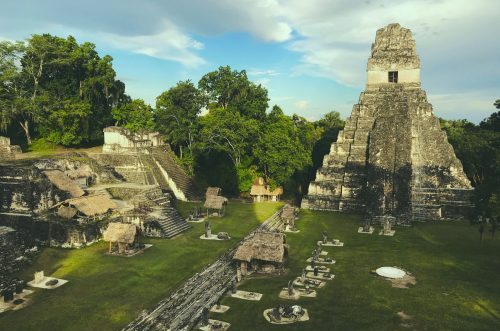
Twitter